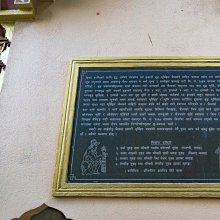Samkalana, Saṅkalana, Saṃkalana, Saṃkalanā, Saṃkālana, Sankalana: 16 definitions
Introduction:
Samkalana means something in Hinduism, Sanskrit, Buddhism, Pali, Marathi, Jainism, Prakrit, Hindi. If you want to know the exact meaning, history, etymology or English translation of this term then check out the descriptions on this page. Add your comment or reference to a book if you want to contribute to this summary article.
Alternative spellings of this word include Sankalan.
Images (photo gallery)
In Hinduism
Ganitashastra (Mathematics and Algebra)
Source: archive.org: Hindu MathematicsSaṃkalana (संकलन) or “making together” is another name for Saṃklita (“addition”) which represents one of the twenty operations (logistics) of pāṭīgaṇita (“science of calculation which requires the use of writing material—the board”), according to Pṛthudakasvāmī’s commentary on the Brāhmasphuṭasiddhānta by Brahmagupta, a Sanskrit treatise on ancient Indian mathematics (gaṇita-śāstra) and astronomy from the 7th century.—The Hindu name for addition is saṃkalita (‘made together’). Other equivalent terms commonly used are [e.g., saṃkalana (making together)] [...]. The word saṃkalita has been used by some writers in the general sense of the sum of a series.

Ganita (गणित) or Ganitashastra refers to the ancient Indian science of mathematics, algebra, number theory, arithmetic, etc. Closely allied with astronomy, both were commonly taught and studied in universities, even since the 1st millennium BCE. Ganita-shastra also includes ritualistic math-books such as the Shulba-sutras.
Languages of India and abroad
Pali-English dictionary
Source: BuddhaSasana: Concise Pali-English Dictionarysaṅkalana : (nt.) addition; collection.
Source: Sutta: The Pali Text Society's Pali-English DictionarySaṅkalana, (nt.) (fr. saṃ+kal to produce) addition DA. I, 95; MA. I, 2. (Page 662)

Pali is the language of the Tipiṭaka, which is the sacred canon of Theravāda Buddhism and contains much of the Buddha’s speech. Closeley related to Sanskrit, both languages are used interchangeably between religions.
Marathi-English dictionary
Source: DDSA: The Molesworth Marathi and English DictionarySaṅkalana (सङ्कलन).—n S Addition, summation. 2 Mixing, mingling, blending. 3 Heaping together.
Marathi is an Indo-European language having over 70 million native speakers people in (predominantly) Maharashtra India. Marathi, like many other Indo-Aryan languages, evolved from early forms of Prakrit, which itself is a subset of Sanskrit, one of the most ancient languages of the world.
Sanskrit dictionary
Source: DDSA: The practical Sanskrit-English dictionarySaṃkalana (संकलन) or Saṃkalanā (संकलना).—
1) The act of heaping together.
2) Contact, junction.
3) Collision.
4)
5) Addition (in math.).
Derivable forms: saṃkalanam (संकलनम्).
--- OR ---
Saṃkālana (संकालन).—Burning a corpse, funeral ceremony; न तु संकालनं राज्ञो विना पुत्रेण मन्त्रिणः (na tu saṃkālanaṃ rājño vinā putreṇa mantriṇaḥ) Rām.2.66.15.
Derivable forms: saṃkālanam (संकालनम्).
Source: Cologne Digital Sanskrit Dictionaries: Shabda-Sagara Sanskrit-English DictionarySaṅkalana (सङ्कलन).—nf.
(-naṃ-nā) 1. Contact, junction. 2. Blending, clinging, twining, intermixture. 3. Heaping as corn, &c. n.
(-naṃ) Addition, (in arithmetic.) E. sam with or like, kal to number, aff. yuc or lyuṭ .
Source: Cologne Digital Sanskrit Dictionaries: Benfey Sanskrit-English DictionarySaṃkalana (संकलन).—i. e. sam-kal + ana, I. n., and f. nā. 1. Heaping. 2. Junction, collision, [Kirātārjunīya] 18, 8. 3. Blending, intermixture. Ii. n. Addition.
Source: Cologne Digital Sanskrit Dictionaries: Cappeller Sanskrit-English DictionarySaṃkalana (संकलन).—[neuter] putting or keeping together.
--- OR ---
Saṃkālana (संकालन).—[neuter] the carrying out and burning of a dead body.
Source: Cologne Digital Sanskrit Dictionaries: Monier-Williams Sanskrit-English Dictionary1) Saṃkālana (संकालन):—[=saṃ-kālana] [from saṃ-kal] n. the act of driving (cattle) together (for grazing), [Catalogue(s)]
2) [v.s. ...] carrying out or burning (a corpse), [Rāmāyaṇa] ([varia lectio] saṃ-kalana).
3) Saṃkalana (संकलन):—[=saṃ-kalana] [from saṃ-kala > saṃ-kal] n. (or f(ā). ) joining or adding or holding together, [Kādambarī]
4) [v.s. ...] addition, [Bījagaṇita]
5) [v.s. ...] the act of heaping together, [Horace H. Wilson]
Source: Cologne Digital Sanskrit Dictionaries: Yates Sanskrit-English DictionarySaṅkalana (सङ्कलन):—[sa-ṅkalana] (naṃ-nā) 1. n. Addition. 1. n. f. Junction; intermixing; heaping.
Source: DDSA: Paia-sadda-mahannavo; a comprehensive Prakrit Hindi dictionary (S)Saṃkalana (संकलन) in the Sanskrit language is related to the Prakrit word: Saṃkalaṇa.
[Sanskrit to German]
Sanskrit, also spelled संस्कृतम् (saṃskṛtam), is an ancient language of India commonly seen as the grandmother of the Indo-European language family (even English!). Closely allied with Prakrit and Pali, Sanskrit is more exhaustive in both grammar and terms and has the most extensive collection of literature in the world, greatly surpassing its sister-languages Greek and Latin.
Hindi dictionary
Source: DDSA: A practical Hindi-English dictionarySaṃkalana (संकलन) [Also spelled sankalan]:—(nm) compilation; collection; assemblage; summation; ~[ka/nakarttā] a compiler, assembler.
...
Prakrit-English dictionary
Source: DDSA: Paia-sadda-mahannavo; a comprehensive Prakrit Hindi dictionarySaṃkalaṇa (संकलण) in the Prakrit language is related to the Sanskrit word: Saṃkalana.
Prakrit is an ancient language closely associated with both Pali and Sanskrit. Jain literature is often composed in this language or sub-dialects, such as the Agamas and their commentaries which are written in Ardhamagadhi and Maharashtri Prakrit. The earliest extant texts can be dated to as early as the 4th century BCE although core portions might be older.
Kannada-English dictionary
Source: Alar: Kannada-English corpusSaṃkalana (ಸಂಕಲನ):—
1) [noun] the act or process of collecting (several things or something in a large number).
2) [noun] things so collected.
3) [noun] a collection of poems, stories, songs, excerpts, etc., chosen by the compiler; an anthology.
4) [noun] an adding of two or more numbers to get their sum; addition.
--- OR ---
Saṃkaḷana (ಸಂಕಳನ):—[noun] = ಸಂಕಲನ [samkalana].
Kannada is a Dravidian language (as opposed to the Indo-European language family) mainly spoken in the southwestern region of India.
Nepali dictionary
Source: unoes: Nepali-English DictionarySaṅkalana (सङ्कलन):—n. 1. collection; compilation; 2. anthology; 3. arranging; selection; 4. addition; summation;
Nepali is the primary language of the Nepalese people counting almost 20 million native speakers. The country of Nepal is situated in the Himalaya mountain range to the north of India.
See also (Relevant definitions)
Partial matches: Kalana, Sam, Saan, Cam, Can, Shan.
Query error!
Full-text: Nitisamkalana, Mantrasamkalana, Bhinnasamkalana, Sankalan, Cankalanam, Pinnacankalanam, Anekavarnasankalana, Patuppadana, Shunyaparikarmakashta, Abhinna, Bhargavadeva, Bhinna, Samkalita.
Relevant text
Search found 11 books and stories containing Samkalana, Sam-kalana, Saṃ-kālana, Saṃ-kalana, Saṃkalana, Saṃkalanā, Saṃkālana, Saṃkaḷana, Saṃkalaṇa, San-kalana, Saṅ-kalana, Saṅkalana, Saṅkalaṇa, Sankaḷana, Sankalana, Saṅkaḷana; (plurals include: Samkalanas, kalanas, kālanas, Saṃkalanas, Saṃkalanās, Saṃkālanas, Saṃkaḷanas, Saṃkalaṇas, Saṅkalanas, Saṅkalaṇas, Sankaḷanas, Sankalanas, Saṅkaḷanas). You can also click to the full overview containing English textual excerpts. Below are direct links for the most relevant articles:
Notices of Sanskrit Manuscripts (by Rajendralala Mitra)
Ganitatilaka (Sanskrit text and English introduction) (by H. R. Kapadia)
Part 4 - Permutations and Combinations < [Introduction]
Part 23 - Outlines of Ganitatilaka < [Introduction]
Chaitanya Bhagavata (by Bhumipati Dāsa)
Gauḍīya-bhāṣya < [Chapter 1 - Summary of Lord Gaura’s Pastimes]
Markandeya Purana (by Frederick Eden Pargiter)
Book Reviews < [July – September, 1999]
Activities of the All-India Kashiraj Trust (June 1964 – December 1964) < [Purana, Volume 7, Part 1 (1965)]
Activities of the All-India Kashiraj Trust (July – December, 1966) < [Purana, Volume 9, Part 1 (1967)]
Original Purana-Samhita < [Purana, Volume 8, Part 2 (1966)]

